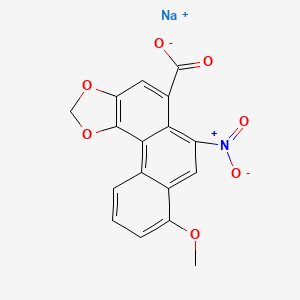

1. 8-methoxy-6-nitrophenanthro(3,4-d)-1,3-dioxole-5-carboxylic Acid
2. Aristolochic Acid
3. Aristolochic Acid A
4. Aristolochic Acid I
5. Aristolochic Acid I, Sodium Salt
6. Tardolyt
1. 10190-99-5
2. Sodium Aristolate 1
3. Sodium Aristolochate-i
4. Aristolochic Acid Sodium Salt
5. Ktm3d3h78e
6. Aristolochic Acid, Sodium Salt
7. Aristolochic Acid, Sodium Salt (77% Aa I, 21% Aa Ii)
8. Sodium;8-methoxy-6-nitronaphtho[2,1-g][1,3]benzodioxole-5-carboxylate
9. Phenanthro(3,4-d)-1,3-dioxole-5-carboxylic Acid, 8-methoxy-6-nitro-, Sodium Salt
10. Ccris 6498
11. Einecs 233-463-4
12. Unii-ktm3d3h78e
13. Mfcd00210760
14. Dsstox_cid_99
15. Sodium 8-methoxy-6-nitrophenanthro(3,4-d)-1,3-dioxole-5-carboxylate
16. Dsstox_rid_75366
17. Dsstox_gsid_20099
18. Chembl3187459
19. Dtxsid3020099
20. Niosh/sf8281000
21. Schembl15537024
22. Aristolochic Acid I, Sodium Salt
23. Tox21_200026
24. Ncgc00257580-01
25. Cas-10190-99-5
26. Ft-0645091
27. Sf82810000
28. Aristolochic Acid I Sodium Salt, Powder, >=97%
29. Aristolochic Acid, Sodium Salt [who-dd]
30. Q27282434
31. Aristolochic Acid Sodium Salt (i And Ii) For Biochemistry
32. Sodium 8-methoxy-6-nitrophenanthro[3,4-d][1,3]dioxole-5-carboxylate
33. 8-methoxy-6-nitrophenanthro(3,4-d)-1,3-dioxole-5-carboxylic Acid Sodium Salt
34. Aristolocholic Acid For System Suitability, European Pharmacopoeia (ep) Reference Standard
35. Phenanthro[3,4-d]-1,3-dioxole-5-carboxylicacid,8-methoxy-6-nitro-,sodium Salt(1:1)
36. 52232-70-9
| Molecular Weight | 363.25 g/mol |
|---|---|
| Molecular Formula | C17H10NNaO7 |
| Hydrogen Bond Donor Count | 0 |
| Hydrogen Bond Acceptor Count | 7 |
| Rotatable Bond Count | 1 |
| Exact Mass | 363.03549594 g/mol |
| Monoisotopic Mass | 363.03549594 g/mol |
| Topological Polar Surface Area | 114 Ų |
| Heavy Atom Count | 26 |
| Formal Charge | 0 |
| Complexity | 544 |
| Isotope Atom Count | 0 |
| Defined Atom Stereocenter Count | 0 |
| Undefined Atom Stereocenter Count | 0 |
| Defined Bond Stereocenter Count | 0 |
| Undefined Bond Stereocenter Count | 0 |
| Covalently Bonded Unit Count | 2 |
Mutagens
Chemical agents that increase the rate of genetic mutation by interfering with the function of nucleic acids. A clastogen is a specific mutagen that causes breaks in chromosomes. (See all compounds classified as Mutagens.)
Carcinogens
Substances that increase the risk of NEOPLASMS in humans or animals. Both genotoxic chemicals, which affect DNA directly, and nongenotoxic chemicals, which induce neoplasms by other mechanism, are included. (See all compounds classified as Carcinogens.)